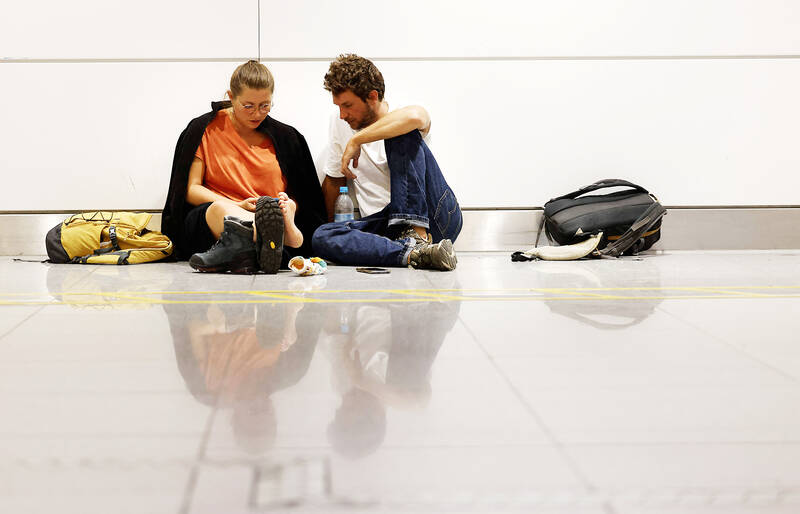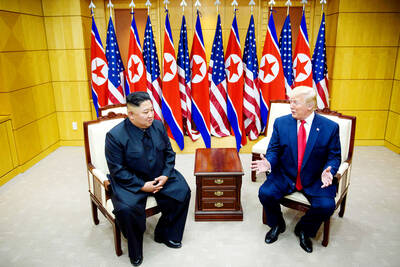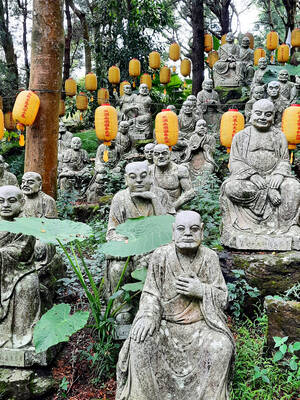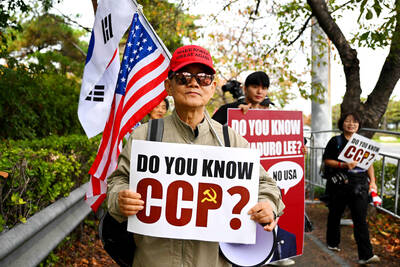It’s late at night, and you have been stewing all day about something your partner did to annoy you. The time to resolve it is now because, as everyone knows, you should never go to bed angry, right?
Though it’s conventional wisdom, many relationship experts say sticking to such a rule is counterproductive. It may even harm the relationship.
“It’s completely wrong,” said Samantha Whiten, a clinical psychologist in Maryland. “All it does is make sure that people are fighting when they’re tired.”

Photo: AFP
Instead, couples can learn habits that help them get rest while boosting the relationship long term.
NO ONE WANTS TO GO TO BED ANGRY
It’s understandable to want to discuss a problem before letting it fester, Whiten said, but it’s unrealistic to expect conflicts to be wrapped up quickly and lovingly before drifting off to sleep.
“That sounds nice,” she said. “That’s like a fairy tale, though.”
Some sources attribute the origin of the phrase to the New Testament book of Ephesians. Translations vary, but it’s some version of: “Be angry but do not sin; do not let the sun set on your anger.”
The trouble is, couples shouldn’t fight when they are “emotionally dysregulated,” Whiten said. She referred to the acronym HALT, a common reminder in therapy that people should avoid serious discussions when hungry, angry, lonely or tired. Many people also drink alcohol at night, which doesn’t help create a calm environment.
“They are more likely to say and do things impulsively that they may regret,” she said.
WHAT SHOULD YOU DO INSTEAD?
Discussing problems at night might seem easiest because it’s when your partner is most available, said Sabrina Romanoff, a clinical psychologist in New York City.
But it’s better to acknowledge that something needs to be discussed, take a pause, and set a time to come back to it, she said. That could mean having lunch or coffee together the next day, or any time you’re not rushing out the door.
The key is to follow through.
“It speaks to a skill, to trust that your partner is really going to return to this thing that’s really important to you,” Romanoff said, adding that most couples have to practice that.
It’s also about understanding your partner and being empathetic to what each of you needs. When one partner needs space, it’s incumbent on the other person not to interpret that space as rejection, Romanoff said.
What’s the difference between a pause and avoiding?
Whiten said many couples in her practice have at least one person who feels they won’t be able to sleep until they resolve a fight. That’s often a sign of anxiety and a discomfort with uncertainty.
“People need to individually learn how they can regulate themselves and tell themselves it’s OK,” she said. “The idea of being able to self-soothe is really key.”
The reverse — avoidance — is no better. Many people might need space to process an argument, but they’re obliged to come back later to their partner to address the topic.
The goal is that both people feel secure enough to acknowledge the disagreement, remember their relationship is more important than one argument, and agree to talk about it later, Whiten said. “When people can learn to do that, it’s really transformative.”
STOP ARGUMENTS BEFORE THEY START
Romanoff suggested that couples establish regular check-ins. They don’t have to talk about the worst problems in their lives at a given point, but they should make a habit of small gestures of communication.
Even regularly asking how your partner’s day went creates a kind of scaffolding of emotional safety, she said. It creates the space to address problems.
When there is an issue, use “I” statements, be clear about what you need, and try to create a plan for how the other person can deliver, she said. A request posed at an appropriate time will often be better received.
“Timing is everything when it comes to communication,” she said.

US President Donald Trump may have hoped for an impromptu talk with his old friend Kim Jong-un during a recent trip to Asia, but analysts say the increasingly emboldened North Korean despot had few good reasons to join the photo-op. Trump sent repeated overtures to Kim during his barnstorming tour of Asia, saying he was “100 percent” open to a meeting and even bucking decades of US policy by conceding that North Korea was “sort of a nuclear power.” But Pyongyang kept mum on the invitation, instead firing off missiles and sending its foreign minister to Russia and Belarus, with whom it

When Taiwan was battered by storms this summer, the only crumb of comfort I could take was knowing that some advice I’d drafted several weeks earlier had been correct. Regarding the Southern Cross-Island Highway (南橫公路), a spectacular high-elevation route connecting Taiwan’s southwest with the country’s southeast, I’d written: “The precarious existence of this road cannot be overstated; those hoping to drive or ride all the way across should have a backup plan.” As this article was going to press, the middle section of the highway, between Meishankou (梅山口) in Kaohsiung and Siangyang (向陽) in Taitung County, was still closed to outsiders

President William Lai (賴清德) has championed Taiwan as an “AI Island” — an artificial intelligence (AI) hub powering the global tech economy. But without major shifts in talent, funding and strategic direction, this vision risks becoming a static fortress: indispensable, yet immobile and vulnerable. It’s time to reframe Taiwan’s ambition. Time to move from a resource-rich AI island to an AI Armada. Why change metaphors? Because choosing the right metaphor shapes both understanding and strategy. The “AI Island” frames our national ambition as a static fortress that, while valuable, is still vulnerable and reactive. Shifting our metaphor to an “AI Armada”

The Chinese Communist Party (CCP) has a dystopian, radical and dangerous conception of itself. Few are aware of this very fundamental difference between how they view power and how the rest of the world does. Even those of us who have lived in China sometimes fall back into the trap of viewing it through the lens of the power relationships common throughout the rest of the world, instead of understanding the CCP as it conceives of itself. Broadly speaking, the concepts of the people, race, culture, civilization, nation, government and religion are separate, though often overlapping and intertwined. A government